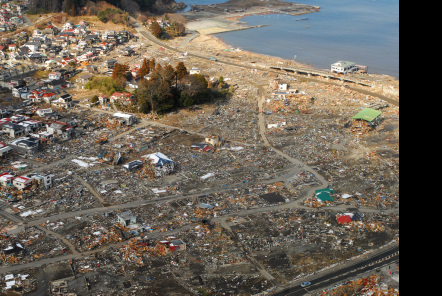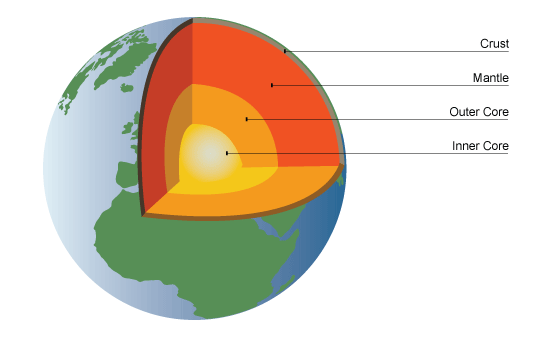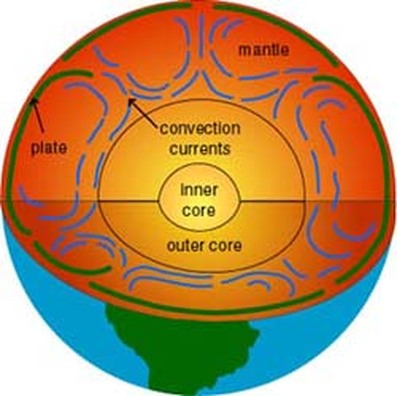Shifting Planet - Plate Tectonics
|
Objective: To discover how our planet it structured and how tectonic plates move and their resultant features.
Starter: Complete the starter task on the work booklet using the information on this page. (below) Task 1 - It is a good skill to be able to complete sketch maps in IGCSE Geography. To make your life a little more difficult, you are going to plot the information above but onto the blank Pacific Centred map in your work booklet. Don't forget to add your own key to the Pacific Map.
Label each of the plates and add the direction arrows and identify and label 'The Pacific Ring of Fire'. Task 2 - There are two types of 'earth's crust': i. Oceanic Crust ii. Continental Crust Using this link, explain the main differences between them both. On the Move - Continental Drift Watch the video to the right hand side. Stop the video when you recognise any landmass e.g. North America. What period was that? Task 3 - Using your work booklet annotate the major differences between now and in the future. Try to find at least five differences. How has the location of your home country changed? Why do we move? Task 4 - Study the cross section diagram to the right that shows a new feature - convection currents. Watch the quick video below too for extra explanation. On the last page of your worksheet, sort out the 8 statements below into the correct order underneath. Don't forget to add a title to your work. The process is known as convection current circulation. The rising and falling magma creates circular currents within the mantle The less dense magma then starts to rise towards the crust The cooling magma becomes denser and begins to sink As the magma warms it expands and becomes less dense. The currents create friction with the crust above and causes it to move. Magma (semi-molten rock) near the outer core is heated. As the magma nears the crust it begins to cool. |
|
Tectonics & Volcanoes
Objective: To link volcanic activity to plate boundary locations and to find out why some volcanoes are more violent than others.
|
Starter: How do volcanoes work? - Click here to access a fantastic infographic that contains everything you need to know.
Task 1 - Watch the first 15 minutes of the YouTube video (Montserrat, Etna & Smoke Rings). This is a video featuring John Seach, a very famous vulcanologist. Here is his website (Volcano Live). Have a look at some of the videos he has taken - amazing! Task 2 - Internet Based - Find the locations of the following volcanoes: a. Mount St Helens b. Cotopaxi c. Mont Pelée d. Eyjafjallajokull e. Mount Vesuvius f. Krakatoa g. Mount Pinatubo h. Mount Ontake (current 2014 eruption here) i. Mount Etna j. Nevado del Ruiz Plot and annotate the locations of these volcanoes onto this worksheet (or a Google Map) and complete the extra task too.
See if you can find Mount St Helens on Google Earth and take a 3D tour inside the crater! |
|
Task 3 - Read slides 3-5 carefully on the embedded presentation above, right.
i. In your books, copy the definition of a destructive (convergent) plate boundary (p.5)
ii. Copy the diagram and answer the question on page 6. Use the hint slide on page 7 to help you
i. In your books, copy the definition of a destructive (convergent) plate boundary (p.5)
ii. Copy the diagram and answer the question on page 6. Use the hint slide on page 7 to help you
Task 4 - Study the interactive resource above. On the last slide, use the information to make a factsheet showing the three different types of volcanoes. Include the following for each of the three types of volcano:
1. How it is constructed
2. The type of eruption
3. A sketch (by hand) of the cross sectional shape
4. A photo of the actual volcano with name and location added.
1. How it is constructed
2. The type of eruption
3. A sketch (by hand) of the cross sectional shape
4. A photo of the actual volcano with name and location added.
Tectonics & Earthquakes

Objective:To understand where earthquakes occur in the world and the processes that cause the event to take place.
Learner Profile Link. Empathy and Knowledgeable.
Starter: How do earthquakes work? - Click here to access a fantastic infographic that contains everything you need to know.
Task 1 - Internet Based. Click here to access the Wikipedia information on earthquakes and in particular the most powerful quakes of all time.
Plot the top 10 earthquake (by magnitude) locations onto the same sheet that you plotted the volcanoes on or on the A3 worksheet below. Use a suitable symbol and complete the key too.
Task 2 - Scroll down the Wikipedia entry to view the figures for the most deadly earthquakes of all time. What is the relationship between the magnitude of an earthquake and the death rate? What other factors could be responsible? Add your responses to your worksheet.
Task 3 - Using the OCR B Textbook, page 122-123, students should read over the text before attempting the following activities on this worksheet
Learner Profile Link. Empathy and Knowledgeable.
Starter: How do earthquakes work? - Click here to access a fantastic infographic that contains everything you need to know.
Task 1 - Internet Based. Click here to access the Wikipedia information on earthquakes and in particular the most powerful quakes of all time.
Plot the top 10 earthquake (by magnitude) locations onto the same sheet that you plotted the volcanoes on or on the A3 worksheet below. Use a suitable symbol and complete the key too.
Task 2 - Scroll down the Wikipedia entry to view the figures for the most deadly earthquakes of all time. What is the relationship between the magnitude of an earthquake and the death rate? What other factors could be responsible? Add your responses to your worksheet.
Task 3 - Using the OCR B Textbook, page 122-123, students should read over the text before attempting the following activities on this worksheet
|
|
|




